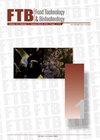风味酶和碱性蛋白酶处理对花生过敏原 Ara h 1 的结构和过敏性的影响
IF 2.5
4区 农林科学
Q3 BIOTECHNOLOGY & APPLIED MICROBIOLOGY
引用次数: 0
摘要
研究背景。花生过敏对人类健康构成重大威胁,因为低剂量的花生过敏会增加长期发病的风险。改变蛋白质结构以影响过敏性是一个热门话题。实验方法。在这项研究中,纯化的花生过敏原 Ara h 1 被香精酶、碱性蛋白酶或两者的组合酶水解。测量了 Ara h 1 与抗体的结合能力以及 Caco-2 细胞中促炎因子 IL-5 和 IL-6 的基因表达和分泌水平。通过圆二色性和 SDS-PAGE 分析了 Ara h 1 处理前后二级和三级结构的变化。结果表明,Ara h 1 的致敏性和促炎能力均有所降低。评估结果表明,香精酶和碱性蛋白酶处理会导致颗粒缩短和聚集。在两种蛋白酶的联合处理下,荧光发射峰增强,增加了 3.4 倍。此外,二级结构也发生了变化,疏水性也增加了(联合处理后增加了 8.95 倍)。新颖性和科学贡献。这些发现为开发一种新的花生脱敏方法和部分揭示花生致敏机理提供了有效的理论依据。本文章由计算机程序翻译,如有差异,请以英文原文为准。
Effects of Flavourzyme and Alkaline Protease Treatment on Structure and Allergenicity of Peanut Allergen Ara h 1
Research background. Peanut allergy poses a significant threat to human health due to the elevated risk of long-term morbidity at low doses. Modifying protein structure to influence sensitization is a popular topic.
Experimental approach. In this study, the purified peanut allergen Ara h 1 was enzymatically hydrolysed using flavorzyme, alkaline protease or a combination of both. The binding ability of Ara h 1 to antibodies, and gene expression and secretion levels of the pro-inflammatory factors IL-5 and IL-6 in Caco-2 cells was measured. Changes in the secondary and tertiary structures before and after treatment with Ara h 1 were carried out by circular dichroism and SDS-PAGE.
Results and conclusions. The results indicated a reduction in the allergenicity and pro-inflammatory ability of Ara h 1. The evaluation reveals that the flavorzyme and alkaline protease treatments caused particle shortening and aggregation. The fluorescence emission peak was enhanced, increasing by 3.4-fold upon combined treatment with both proteases. Additionally, the secondary structure underwent changes, and the hydrophobicity also increased (8.95-fold upon combined treatment).
Novelty and scientific contribution. These findings provide an effective theoretical basis for developing a new method of peanut desensitization and partially uncovering the mechanism of peanut sensitization.
求助全文
通过发布文献求助,成功后即可免费获取论文全文。
去求助
来源期刊

Food Technology and Biotechnology
工程技术-生物工程与应用微生物
CiteScore
3.70
自引率
0.00%
发文量
33
审稿时长
12 months
期刊介绍:
Food Technology and Biotechnology (FTB) is a diamond open access, peer-reviewed international quarterly scientific journal that publishes papers covering a wide range of topics, including molecular biology, genetic engineering, biochemistry, microbiology, biochemical engineering and biotechnological processing, food science, analysis of food ingredients and final products, food processing and technology, oenology and waste treatment.
The Journal is published by the University of Zagreb, Faculty of Food Technology and Biotechnology, Croatia. It is an official journal of Croatian Society of Biotechnology and Slovenian Microbiological Society, financed by the Croatian Ministry of Science and Education, and supported by the Croatian Academy of Sciences and Arts.
 求助内容:
求助内容: 应助结果提醒方式:
应助结果提醒方式:


